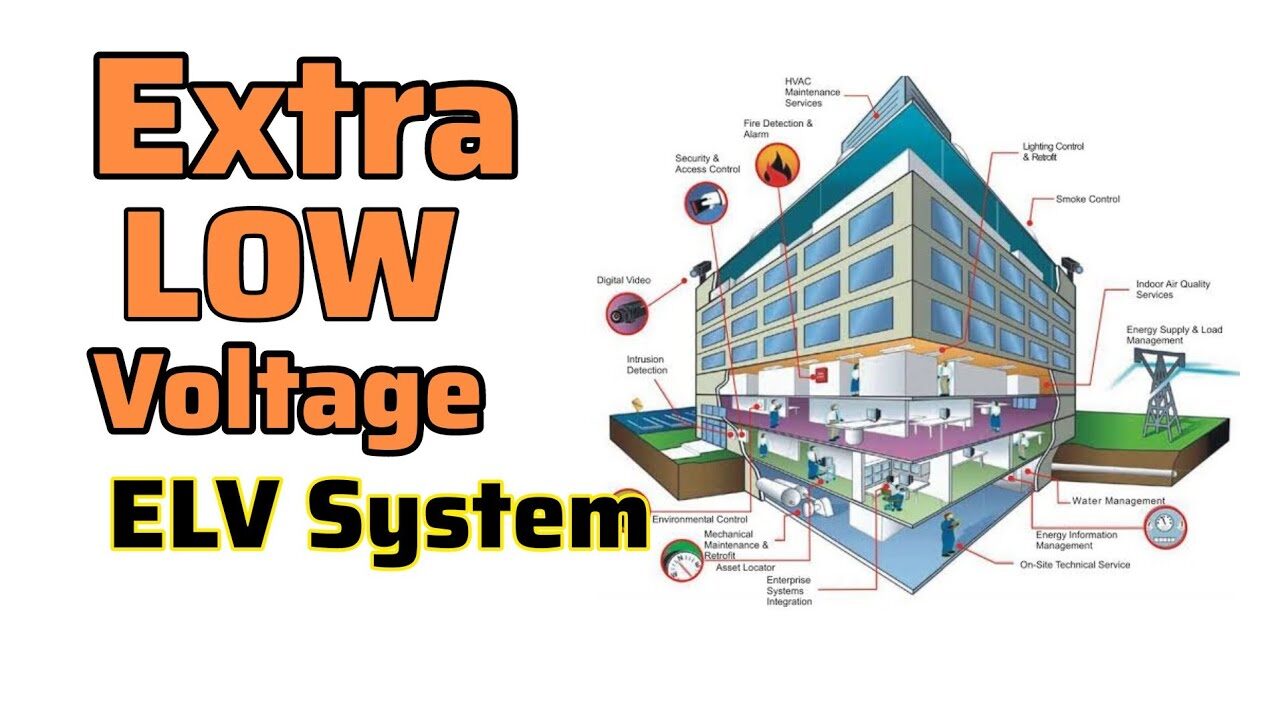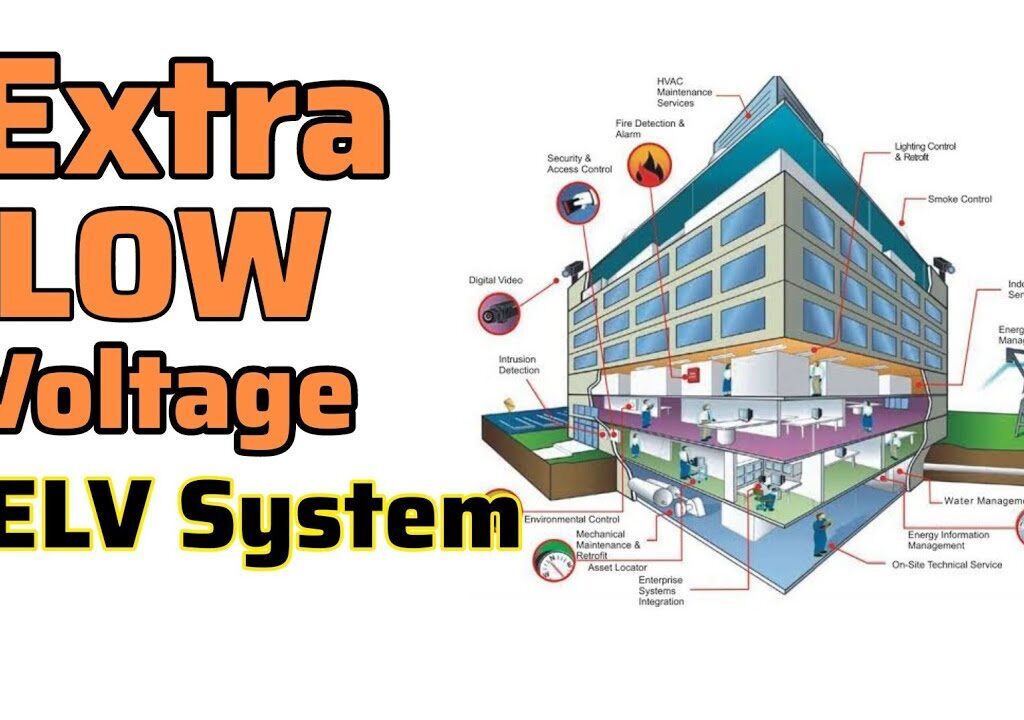Imagine a building that hums with a life of its own. Lights adjust automatically as you walk in, security systems seamlessly identify authorized personnel, and information flows freely through a network of interconnected devices. This isn’t a scene from a sci-fi movie; it’s the reality of smart buildings, powered by the invisible orchestra of Extra-Low Voltage (ELV) systems.

But what exactly are ELV systems, and how do they play a crucial role in creating these intelligent buildings? Let’s delve into the world behind the scenes, where low voltage sparks a high-tech revolution.
The Power Behind the Curtain: Unveiling ELV Systems
Think of ELV systems as the nervous system of a building. They operate on a safe and efficient low-voltage current, handling a wide range of functions that go beyond the basic power supply. These systems include:
- Security Systems: From access control systems that verify identities to CCTV cameras that keep a watchful eye, ELV systems ensure the safety and security of occupants and assets.
- Communication Networks: These include telephone systems, data networks, and public address systems, forming the backbone for seamless communication within and outside the building.
- Building Automation Systems (BAS): These systems act as the brain of the building, controlling everything from lighting and HVAC (Heating, Ventilation, and Air Conditioning) to fire alarms and energy management.
- Other Systems: ELV systems also encompass intercoms, audio-visual systems, and even guest room management systems in hospitality settings.
In essence, ELV systems provide the essential infrastructure for a building’s intelligent operations. They ensure smooth communication, optimal security, and efficient control over various functions.
The Rise of the Smart Symphony: ELV Systems Meet IoT
Now, let’s add another layer of magic to the mix – the Internet of Things (IoT). Imagine these ELV systems no longer operating in isolation but seamlessly integrated with an IoT platform. Sensors embedded in various systems collect real-time data on everything from occupancy levels to energy consumption. This data feeds into the IoT platform, which uses it to automate tasks and optimize building performance.
The benefits of this integration are numerous:
- Enhanced Security: IoT-powered access control systems can grant or deny entry based on real-time factors like location or time constraints. Video analytics can detect suspicious activities and trigger automated responses.
- Intelligent Lighting Control: IoT sensors can detect occupancy and adjust lighting levels accordingly, saving energy and creating a more dynamic environment.
- Personalized Comfort Control: Imagine a building that learns your preferences. IoT-enabled BAS can adjust temperature and ventilation based on your presence, ensuring optimal comfort with minimal energy waste.
- Predictive Maintenance: By analyzing sensor data, the system can predict potential equipment failures and schedule preventive maintenance, minimizing downtime and saving costs.
The possibilities become truly endless. Imagine a building that automatically adjusts its energy consumption based on weather forecasts or a communication system that seamlessly integrates with smart devices for improved occupant experience.

The Specific Notes in the Symphony: IoT Applications for ELV Systems
Let’s delve deeper into specific applications of ELV systems with IoT in key areas:
- Security: Facial recognition technology integrated with access control systems can further enhance security. IoT-enabled cameras can trigger alerts when unusual activity is detected in specific zones.
- Lighting Control: Imagine a conference room that automatically adjusts lighting levels based on the number of occupants and the type of presentation being held. This not only saves energy but also enhances the effectiveness of the presentation.
- Occupant Experience: IoT-enabled sensors can detect a room’s temperature and humidity and adjust the HVAC system accordingly. Additionally, integration with smart building apps allows occupants to control lighting and temperature remotely, enhancing convenience and comfort.
These are just a few examples, and as technology advances, the possibilities for integrating ELV systems with IoT will continue to expand.
Building a Smarter Future: The Final Crescendo
The integration of ELV systems and IoT represents a paradigm shift in building management. It paves the way for smarter, more efficient, and sustainable buildings that adapt to our needs and optimize resource utilization. This collaborative effort requires not just technological advancements but also a shift in mindset. Building owners, architects, engineers, and facility managers must work together to create a holistic approach that seamlessly integrates ELV systems and IoT throughout the building lifecycle.
By harmonizing these elements, we can create a symphony of intelligence, transforming buildings into thriving ecosystems that enhance our well-being and contribute to a more sustainable future.
FAQs
1. What are some of the challenges associated with integrating ELV systems with IoT?
Challenges include cybersecurity concerns, data privacy considerations, and ensuring interoperability between different systems and platforms
2. How can I secure my building’s ELV system integrated with IoT?
Implement a layered security approach. This includes strong passwords, network segmentation, secure communication protocols, and regular security audits. Staying updated on the latest cybersecurity threats is crucial.
3. What are some of the benefits of using an IoT platform for managing ELV systems?
IoT platforms provide centralized data collection, visualization, and analysis. This allows for better decision-making, improved efficiency, and easier identification of trends and potential issues within the ELV system.
4. What skills are required to design and maintain ELV systems integrated with IoT?
A strong understanding of traditional ELV systems, coupled with knowledge of IoT technologies, data analytics, and cybersecurity is essential. Additionally, familiarity with specific ELV system protocols and IoT platforms relevant to the project is beneficial.
5. Where can I learn more about ELV systems and their integration with IoT?
Industry organizations like NECA (National Electrical Contractors Association) and BICSI (Building Industry Consulting Services International) offer resources and training programs on ELV systems and smart buildings. Additionally, many IoT platform providers offer training materials specific to their platforms and their application with ELV systems.
Conclusion: Building a Symphony of Intelligence
The future of buildings is undoubtedly smart, and ELV systems play a central role in orchestrating this intelligence. By embracing the power of IoT and fostering collaboration across disciplines, we can transform our buildings into true marvels of efficiency, sustainability, and occupant well-being. Let’s join the chorus and build a symphony of intelligence, one ELV system integration at a time.


